4 Types of Tissue in Our Bodies
Scientists can’t tell the exact number of cells we have, but it could be around 30-40 trillion. Optimizing the cells into different types of tissue with a specific structure and function, where cells have a similar design, origin, and function, is easier to understand.
So, in case you’re wondering, 5-Minute Crafts rounded up 4 primary tissue types a human body has.
1. Epithelial tissue
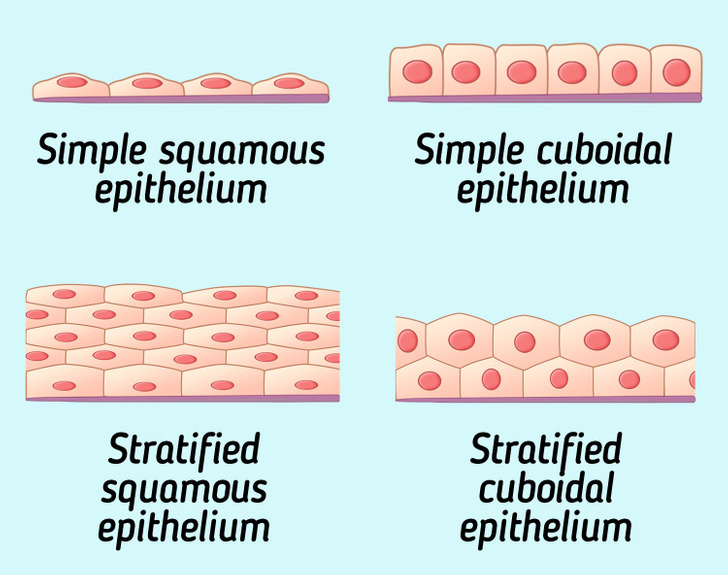
Epithelial tissue is the surface of the human body, covering our skin, mucous membranes of the mouth, nasal cavity, digestive tract, etc. There are no blood vessels in epithelial tissue, so it gets nutrients from the adjacent connective tissue.
- It lines the mucous membranes of internal organs, forms the inner membrane of blood vessels and body cavities, and forms the human body’s glands. It consists of cells closely packed with almost no intercellular spaces between them.
- It has its nerve supply with a high rate of cell division that allows the tissue to continually renew and repair itself by replacing dead or injured cells with new ones.
- Epithelial cells show polarity; organelles and membrane proteins are unevenly spread inside a cell.
- They come in different shapes and sizes, varying from tall columnar to cuboidal to low squamous, whose size and morphology are based on their function.
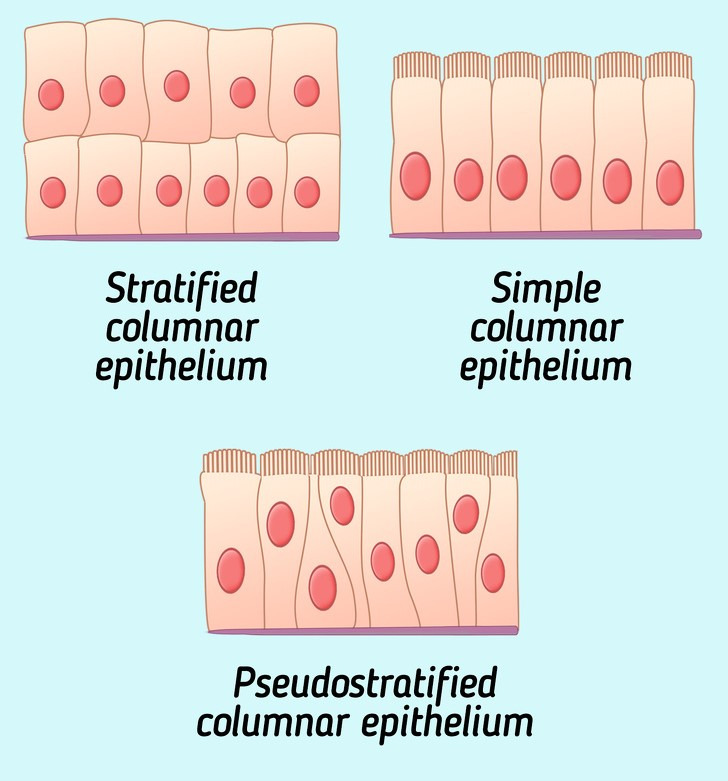
Epithelial tissue has many functions in our bodies:
- Protection: It covers our body and protects the underlying cells from drying out, getting damaged, and coming into contact with toxins.
- Exchange and filtration: It performs and removes metabolic products from the body. Also, some tissue, like the intestinal epithelium, can absorb water and nutrients — epithelial tissue cells direct them further into the body.
- Secretion: The external, internal, and mixed secretion glands formed by the epithelium secrete hormones, enzymes, and other substances responsible for many bodily functions.
- Receptor function: It can recognize sensory information and convert it into nerve impulses. The epithelial cells of the nasal mucosa, with particular cilia, allow the odor-smelling sensation.
2. Connective tissue
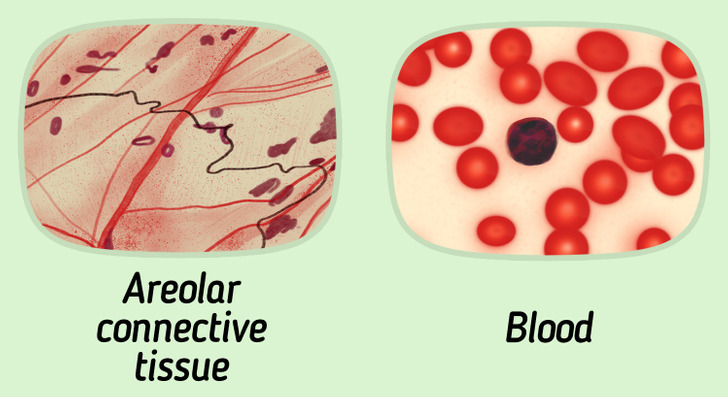
As the name suggests, connective tissue, which also includes the blood and lymphatic system, provides the connection and distribution of nutrients between tissue and organs in the body and forms our bones, cartilage, and body fat. Connective tissue cells are dispersed in a substance called the intercellular matrix; cells in epithelial tissue are in close contact.
- Different connective tissue types differ significantly, but they usually have 3 main components: cells, a large amount of a basic substance, and protein fibers. The primary substance can be liquid or solid, like bones.
- All, except for cartilage, contain many blood vessels. A good blood supply facilitates the transport of nutrients, oxygen, and water and eliminates waste.
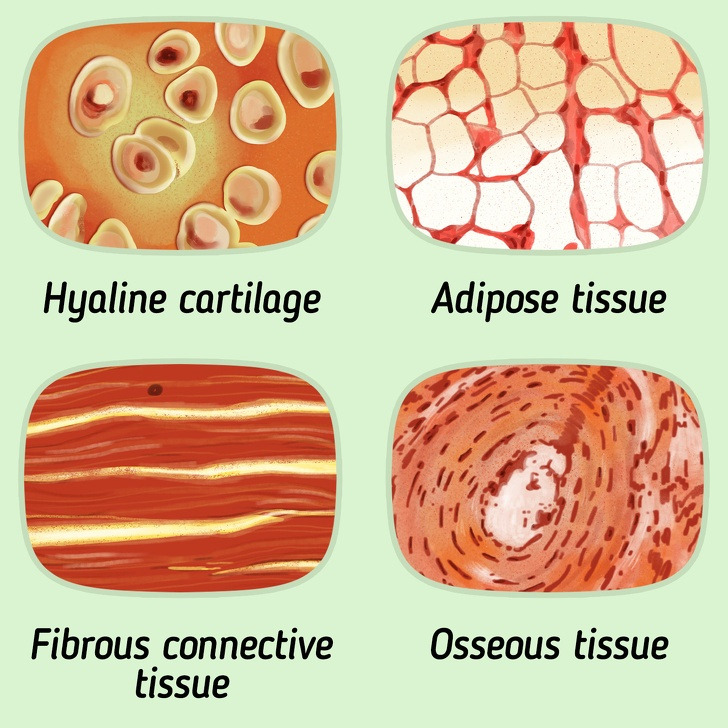
- It connects various tissues and organs of the body and protects internal organs. Dense connective tissue, like bones and cartilage, forms the body’s skeleton and supports the internal organs.
- The lymphocytes and leukocytes are connective tissue cells and protect the body from various infections. Blood participates in the nourishing process of the body, carrying oxygen, water, and nutrients to other cells and tissue. The adipose tissue under the skin stores energy and provides insulation to the body.
3. Muscle tissue
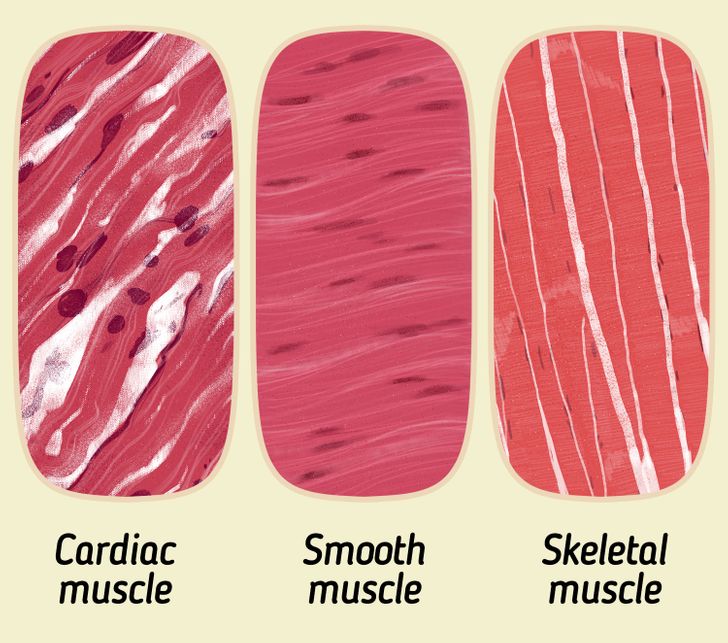
Muscle tissue is a soft tissue made of cells capable of contraction, which consists of all muscles in our body and the muscles on the face, torso, limbs, and heart. Together with tendons, it forms the human muscular system and is responsible for bodily movement and keeping the body in one position. Characterized by elasticity and extensibility, it quickly reacts to stimuli and allows stretching without tearing and returning to the previous state. There are 3 types:
- Skeletal muscle is responsible for body movement. It provides stability to the joints and supports the organs within the body. Muscles help maintain the correct body temperature by generating heat.
- Cardiac muscle contracts the heart, pumping blood through it. The body’s primary “pump” is the heart muscle that supplies blood.
- Smooth muscle forms organs, such as the stomach and bladder, and enables them to function effectively. It’s responsible for the movement of food through the digestive system and is involved in regulating blood pressure by altering systemic vascular resistance.
4. Nervous tissue
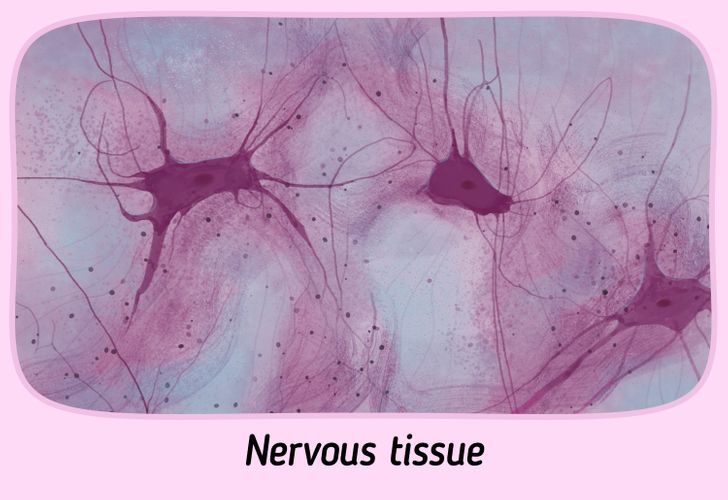
Nervous tissue, consisting of nerve ganglia, brain, and spinal cord, makes up the human nervous system. The main components of nervous tissue are neurons, which perceive stimuli, generate nerve impulses, and send signals to different body parts. Special cells called glial cells support the nerve cells.
- Neurons of nervous tissue transmit impulses from the 5 senses to the central nervous system, allowing us to feel the world around us. It ensures the coordinated activity of all organ systems.
- It controls all bodily movements and responds actively to changes in the external environment. It participates in the processes of excitement and relaxation. It also plays a vital role in digestion, causes the pupils of the eyes to dilate, and increases sweat secretion and heart rate.
Bonus: the link between a toothache and a headache
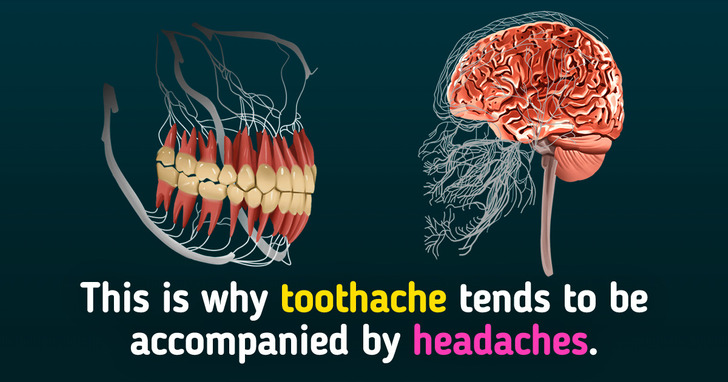
Toothaches, mild or severe, are one of the most common problems and can happen for various reasons. If you’ve never experienced a toothache, you’re lucky. But if you have, perhaps you may know that when not treated, it may grow more painful and cause headaches too. So you can’t help but wonder if toothaches and headaches are connected.
Because of the many nerve connections, you may feel pain in different parts of your body. It’s known as ’’referred pain.’’ Similarly, when you experience a toothache because of so many nerve connections, the pain travels along them — via the trigeminal nerves, which are the dominant nerve groups covering most of your head, face, and jaw, as well as facial and eye movements and sensations. They connect the teeth and other facial structures to the brain. Therefore, you feel headaches alongside toothaches.
Note: If you want to learn more about ’’pain’’ and how it’s measured, check out our other articles!
To see how pain is measured, click here.